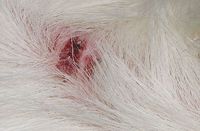Difference between revisions of "Trixacarus"
| (13 intermediate revisions by 3 users not shown) | |||
| Line 1: | Line 1: | ||
| − | {{ | + | {{OpenPagesTop}} |
| + | {{Taxobox | ||
| + | |name = ''Trixacarus'' | ||
| + | |phylum = [[:Category:Arthropods|Arthropoda]] | ||
| + | |class = [[:Category:Arachnida|Arachnida]] | ||
| + | |order = Astigmata | ||
| + | |family = Sarcoptidae | ||
| + | |genus = Trixacarus | ||
| + | }} | ||
| + | Also known as: '''''Selnick mite | ||
| + | ==Introduction== | ||
[[Image:trixacarus.jpg|thumb|right|200px|''Trixacarus infestation in a guinea pig.'' - Uwe Gille 2008,Wikimedia Commons]] | [[Image:trixacarus.jpg|thumb|right|200px|''Trixacarus infestation in a guinea pig.'' - Uwe Gille 2008,Wikimedia Commons]] | ||
| − | + | ''Trixacarus'' mites are [[Burrowing Mites|burrowing mites]] of rodents. They cause Trixacaral mange, particularly in guinea pigs. | |
| − | |||
| − | |||
| − | |||
| − | |||
| − | |||
| − | |||
| − | |||
| − | |||
==Identification== | ==Identification== | ||
| − | The mites are similar to [[Sarcoptes|''Sarcoptes'']] mites, but half the size. The mites can be identified from [[Notoedres|''Notoedres']] mites by their prominent sharp dorsal spines. | + | The mites are similar to [[Sarcoptes|''Sarcoptes'']] mites, but half the size. The mites can be identified from [[Notoedres|''Notoedres'']] mites by their prominent sharp dorsal spines. |
==Life cycle== | ==Life cycle== | ||
| − | Trixacarus mites have a '''3 week''' life cycle and can only survive a few weeks off the host. They are species specific and can be transmitted through direct contact, particularly through close contact between mother and offspring. | + | ''Trixacarus'' mites have a '''3 week''' life cycle and can only survive a few weeks off the host. They are species specific and can be transmitted through direct contact, particularly through close contact between mother and offspring. |
==Infection== | ==Infection== | ||
| Line 30: | Line 32: | ||
==Important Species== | ==Important Species== | ||
| − | ''Trixacarus caviae''- This species causes mange in guinea pigs. | + | ''Trixacarus caviae'' - This species causes [[Mites - Guinea Pigs#Burrowing Mites|mange in guinea pigs]]. |
| − | ''Trixacarus diversus''- This species causes mange in rats, mice and hamsters. | + | ''Trixacarus diversus'' - This species causes mange in rats, mice and hamsters. |
| + | |||
| + | {{Learning | ||
| + | |flashcards = [[Mites_Flashcards|Mites Flashcards]] | ||
| + | |literature search = [http://www.cabdirect.org/search.html?q=title:(%22Trixacarus%22)+ ''Trixacarus'' publications] | ||
| + | |Vetstream = [https://www.vetstream.com/canis/search?s=mite Mites] | ||
| + | }} | ||
==References== | ==References== | ||
| − | |||
| + | Kummel BA, Estes SA, Arlian LG. (1980) '''''Trixacarus caviae'' infestation of guinea pigs.''' J Am Vet Med Assoc. 1;177(9):903–908. | ||
| − | + | {{OpenPages}} | |
| − | |||
| − | |||
[[Category:Burrowing_Mites]] | [[Category:Burrowing_Mites]] | ||
| − | |||
| − | |||
| − | |||
Latest revision as of 17:15, 4 June 2016
| Trixacarus | |
|---|---|
| Phylum | Arthropoda |
| Class | Arachnida |
| Order | Astigmata |
| Family | Sarcoptidae |
| Genus | Trixacarus |
Also known as: Selnick mite
Introduction
Trixacarus mites are burrowing mites of rodents. They cause Trixacaral mange, particularly in guinea pigs.
Identification
The mites are similar to Sarcoptes mites, but half the size. The mites can be identified from Notoedres mites by their prominent sharp dorsal spines.
Life cycle
Trixacarus mites have a 3 week life cycle and can only survive a few weeks off the host. They are species specific and can be transmitted through direct contact, particularly through close contact between mother and offspring.
Infection
The mites cause severe pruritus in laboratory rodents and guinea pigs. Their burrowing activity causes biting, scratching and irritation. This leads to to inflammation, pruritus and alopecia. Affected areas show acanthosis and hyperkeratosis. Death can occur within 3-4 months of infection if it is not treated.
Diagnosis
Mite infection can be diagnosed by clinical signs and a skin scrape of a 'non-scratched' region.
Important Species
Trixacarus caviae - This species causes mange in guinea pigs.
Trixacarus diversus - This species causes mange in rats, mice and hamsters.
| Trixacarus Learning Resources | |
|---|---|
To reach the Vetstream content, please select |
Canis, Felis, Lapis or Equis |
 Test your knowledge using flashcard type questions |
Mites Flashcards |
 Search for recent publications via CAB Abstract (CABI log in required) |
Trixacarus publications |
References
Kummel BA, Estes SA, Arlian LG. (1980) Trixacarus caviae infestation of guinea pigs. J Am Vet Med Assoc. 1;177(9):903–908.
Error in widget FBRecommend: unable to write file /var/www/wikivet.net/extensions/Widgets/compiled_templates/wrt69368fd8688cf1_51211602 Error in widget google+: unable to write file /var/www/wikivet.net/extensions/Widgets/compiled_templates/wrt69368fd8721028_96436331 Error in widget TwitterTweet: unable to write file /var/www/wikivet.net/extensions/Widgets/compiled_templates/wrt69368fd87c2646_44166955
|
| WikiVet® Introduction - Help WikiVet - Report a Problem |
